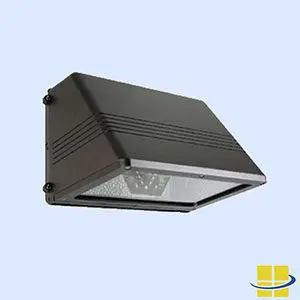If it is time to purchase new lighting such as LED high bay luminaires or LED wall packs, you likely have already seen how confusing it can be to navigate all of the style, wattage, and Kelvin options. This process is often made even more difficult given the array of terms that are poorly or inconsistently used across the industry. Here are seven terms you need to know to help you compare and select the right LED light fixture for your application.
LED Watts
LED watts or LED light source watts refers to the total watts used by the LEDs, whether chip-on-board (COB) LEDs or an LED array. LED watts does not include the watts used by the driver. Just as with high pressure sodium, metal halide, and other legacy light sources, the watts listed for LEDs are often based on the light source. Many manufacturers will list only the light source watts, not the system watts (see below), as the former is lower and more attractive figure. However, the LED driver adds additional watts; this sum is called system watts and is the most relevant figure to consider.
LED System Watts

LED system watts is the sum total of LED watts and the watts used by the LED driver. For example, the HEZE 50w LED Full Cutoff Wall Pack has a 45-watt LED array that uses 45 LED watts, or LED light source watts. The LED driver adds five watts, for a total of 50 LED system watts.
LED Light Source Lumens
LED light source lumens is the measure of the lumens emitted by the LEDs themselves. This figure is strictly a measure of the lumens emitted by the light source, not measure of lumens that leave the luminaire. This metric is typically touted as a means of efficacy, but what really matters is the LED luminaire lumens (see below).
LED Luminaire Lumens
LED luminaire lumens is the measure of light emitted by the luminaire. While the LEDs might generate 10,000 light source lumens, what matters is the light that actually leaves the luminaire. Clear glass reduces light emitted by approximately 10%, prismatic glass reduces it by 20%, and bent prismatic glass reduces it by 25% or more. An extreme example is a LED louvered bollard light. While the LED bollard light emits 2,089 light source lumens, the louvers direct light down and seriously reduce the LED luminaire lumens. The LED louvered bollard light only emits 371 LED luminaire lumens. Compare the same LED array in an LED bollard light with a cone reflector and polycarbonate lens, which generates the same number of light source lumens but emits 1,389 luminaire lumens.
LED Lumens per Watt

LED lumens per watt is a measure of efficiency. Companies proudly list extraordinary efficacies such as 140 lumens per watt, but what are they really measuring? Are they dividing the LED light source lumens by the LED watts? Or is it LED light source lumens by the LED system watts? Read the fine print. If the information isn’t clear, ask! These figures are too often inflated and skewed to make fixtures seem better than they really are.
LED Luminaire Lumens per Watt
LED luminaire lumens per watt is the measure of light emitted by the luminaire divided by the LED system watts . . . or that is at least what it is supposed to be. One must question if the calculations are made using LED light source lumens, LED luminaire lumens, and then determine if that being divided by LED watts or LED system watts. You may have to gather your own data and do the calculations yourself to make sure you are accurately comparing the performance of two fixtures.
For example, the new BAKU Crescent-Shaped 50w LED Wall Pack has a 45-watt LED array. With the LED driver, the BAKU uses 50 LED system watts. The wall pack emits 5,127 LED luminaire lumens. Dividing the 5,127 light source lumens by 45 LED watts makes for 114 lumens per watt, but this may be a misleading figure. Dividing the 5,127 light source lumens by the 50 LED system watts will provide a more useful figure: 103 LED lumens per watt.
LED Luminaire Lumens per Dollar
One measure of value is LED luminaire lumens per dollar. Dividing LED luminaire lumens by the price of the luminaire is an excellent way to compare two LED luminaires. While there are many other data points to consider, such as the LM70 rating or the color rendering index (CRI) of the lights being compared, LED luminaire lumens per dollar can be a fast method of comparison. Let’s use the ZIBO 50w LED Forward Throw Wall Pack as an example. The ZIBO emits 4,837 LED luminaire lumens and is priced at $129.99. 4,837 divided by $129.99 equals 37.21 LED luminaire lumens per dollar.
Speak to an Access Fixtures Lighting Specialist about Choosing the Right Fixture
Access Fixtures is your factory-direct source for all light fixtures needed to suitably illuminate your property. Are you still unsure of these terms? Are you seeing other terms and looking for an explanation? You can always speak to an Access Fixtures lighting specialist. We want to make sure you get the exact fixture for your needs, your budget, and your goals. We are passionate about lighting and love what we do—we’ll get you an answer. To speak with an Access Fixtures lighting specialist, call (800) 468-9925.






